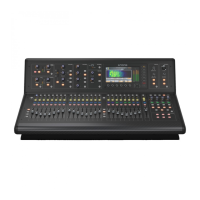90 M32 - Digital Console User Manual 91
Dimension-C
Chorus samples the input, slightly detunes it and mixes it with the original signal to produce a somewhat thicker, shim-
mering sound. Use it to thicken up background vocals, or to double the sound of brass and woodwind instruments. Inspired
by the Roland Dimension D.
Press the rst rotary control to toggle the output signal between Mono and STereo. Pressing the second, third, fourth or
fth rotary controls engages the chorus eect with increasing intensity.
Stereo Phaser
A Stereo Phaser, or phase shaper, applies multiple STAGES of modulated lters to the input signal to create a ‘notch’ in the
frequency response, and then applies a MIX with the original for a ‘swirling’ eect. Use the M32’s Stereo Phaser to add a
‘spaced-out’ sound to vocal or instrumental tracks.
SPEED sets the LFO rate and DEPTH sets the LFO modulation depth.
The BASE rotary control adjusts the frequency range of the modulation lters. The resonance is adjusted with the RESO
rotary control. The WAVE rotary control shapes the symmetry of the LFO waveform, and PHASE dials in an LFO phase
dierence between the left and right channels. The modulation source can also be the signal envelope, which produces
vowel-like opening and closing tones. The ENV MOD rotary control adjusts how much of this eect takes place (positive
and negative modulation is possible), and the ATTACK, HOLD and RELEASE rotary controls all tailor the response of this
feature.
Mood Filter
The Mood Filter uses an LFO generator and an auto-envelope generator to control a VCF (voltage-control lter), as well as
a side-chain function, where the channel B signal controls the envelope of channel A. When applied to electronic instru-
ments, the Mood Filter can be used to emulate the natural sound of acoustic instruments. Inspired by the MiniMoog.
This lter can be modulated with the signal’s envelope using the ENV MOD (with positive and negative amounts), ATTACK
and RELEASE rotary controls, or the LFO can modulate the lter. The WAVE rotary control selects between seven dierent
waveforms - triangular, sine, saw plus, saw minus, ramp, square and random. The PHASE can be oset by up to 180°. The
SPEED rotary control adjusts the rate of the LFO, and DEPTH adjusts the amount of LFO modulation. Adjust the resonance
of the lter until self-oscillation with the RESO(nance) rotary control. BASE adjusts the range of the lter from 20 Hz to
15 kHz. The MODE switch selects between low-pass (LP), high-pass (HP), band-pass (BP) and Notch. Use the MIX rotary
control to blend the aected signal with the dry sound. With the 4 POLE switch engaged there will be a steeper slope than
the OFF (2 pole) setting. The DRIVE rotary control adjusts the level, and can also introduce an overdrive eect (as with real
analogue lters) if pushed hard. In Side-chain mode, only the left input signal is processed and fed to both outputs. The
envelope of the right input signal can be used as a modulation source.
Rotary Speaker
Rotary Speaker emulates the sound of a Leslie rotating speaker. The M32’s Rotary Speaker provides more exibility than
its electro-mechanical counterpart, and can be used with a variety of instruments, and even vocals, to create a whirling,
psychedelic eect.
The LO SPEED and HI SPEED rotary controls adjust the rotation speed of the Slow and Fast speed selection, and can be
toggled with the FAST button. The ACCEL(eration) rotary control adjust how quickly the speed increases and decreases
from the Slow mode to the Fast mode. The rotation eect can also be disengaged with the STOP button, which will stop
the movement of the speakers.
DISTANCE adjust the perceived distance between the speakers and the virtual microphone.
www.theaudiospecialists.eu

